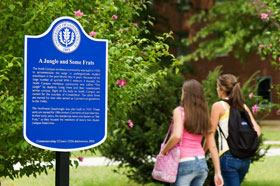  |
| HOME | THIS ISSUE | CALENDAR | GRANTS | BACK ISSUES | < BACK | NEXT > |
Historical markers showcase UConn’s past by Richard Veilleux - September 11, 2006
|
||||
|
A series of historical markers were erected across campus last week, giving the UConn community and visitors an easy-to-read primer on the University's history. Placed in 11 key spots across campus, the signs are close replicas of the historic markers found along the nation's roadsides and at Civil War sites. They highlight people, places, and events in UConn's history, and are part of the University's 125th anniversary celebrations. "It's a great way to give the tens of thousands of students and visitors on campus every year a way to connect to the past, to get a glimpse of some of the building blocks of what today is a magnificent university campus," says Meg Malmborg, director of the Lodewick Visitor's Center and co-chair of the University's 125th anniversary planning committee. Most of the markers highlight buildings that were constructed during the first half of the 20th century, including "Old Campus," the quadrangle formed by the Wilbur Cross Building (1939), Benton Museum (1920), Wood and Hall dorms (1940), Storrs Hall (1905 - UConn's first brick residence hall), and Koons Hall (1913). A marker in front of North Campus explains that those residence halls, as well as Northwest residence halls, were built in 1950 to house the hundreds of returning war veterans who enrolled, noting that North was quickly dubbed "The Jungle," because the veterans were so "spirited." Markers also have been erected at the north end of Mirror Lake (formed in 1922), adjacent to Whitney House and the Honors House, the two oldest buildings on campus; beside the Student Union (built in 1952); behind Hawley Armory (1915); on Gilbert Road, known in the late 1800s and early 1900s as "Faculty Row;" and near the intersection of North Eagleville and Storrs roads, the site of a former orphanage where UConn began in 1881.
The site also is the burial place of Jonathan I, the University's first mascot, who was hit by a car and killed in early 1935, only two months after he was presented to the University by an alumnus. Connecticut State Historian and UConn history professor Walter Woodward, is one of the members of the 125th anniversary planning committee, which conceived the idea. "I had the good fortune of seeing the 125th anniversary exhibit (in Wilbur Cross Building) and reading Bruce Stave's book on UConn's history (Red Brick in the Land of Steady Habits)," he says. "It occurred to me that there were so many moments of tremendous interest in so many places we walk by every day and don't realize it, that historic markers would be an excellent chance to show the community right where it happened - to showcase our rich tradition. "The signs highlight something we historians are always conscious of," adds Woodward, "that a very exciting past is always all around us, shaping both our present and future." Copy for the signs, which were produced by Lauretano Sign Shop of Terryville, was prepared by Mark J. Roy of University Communications. |
| ADVANCE HOME UCONN HOME |

